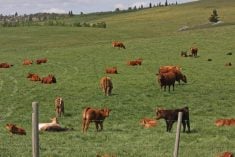Q: We have farmed land under a lease arrangement for 20 years. There is
no written agreement. As part of the deal we have always understood
that we had a right of first refusal. That is, if the land was put up
for sale we would have the right to match any offer. We are concerned
that the land might be put up for sale and want to file a caveat to
protect that right. However, we were told that we cannot protect a
Read Also

Know what costs are involved in keeping crops in the bin
When you’re looking at full bins and rising calf prices, the human reflex is to hold on and hope for more. That’s not a plan. It’s a bet. Storage has a price tag.
right of first refusal. Is this correct?
A: A right of first refusal gives the holder the right to match any
offer of land should the owner decide to sell. Most often it is part of
a lease agreement and gives the tenant the opportunity to buy should
the landlord decide to sell.
As a general rule, it is not considered a property right, but a
contractual right. This means you can’t protect it at the land titles
office, but it is still enforceable against the person who granted it.
For example, Z has given you a right of first refusal, then sells to Y
without giving you a chance to meet any offer. You wouldn’t be able to
get the land, but could sue Z for breach of contract.
A Saskatchewan case, S vs. W, illustrates the law. S entered into a
crop share lease agreement with G. One of the terms of the lease
provided that “in event the landlord wishes to sell this quarter, she
agrees to sell it at $35,500 plus 10 percent” to S.
S filed a caveat claiming an interest under “a crop share lease
agreement with an option to purchase … as to first right of
purchase.” Several years later, G challenged S’s caveat and served S
with notice to lapse the caveat. S consulted a lawyer, but the caveat
was not defended and it was struck off the title. S sued his lawyer
claiming the lawyer did not defend the caveat.
The court ruled that the right to purchase was not an option. Under an
option, the prospective purchaser decides whether and when to offer to
buy the land.
In this case it was G’s call whether to sell and S could only buy if G
decided to sell. Therefore, the court ruled this was a mere contractual
right, like a right of first refusal, and could not be the basis for
the caveat.
Hence, the caveat did not protect a valid right and S did not suffer a
loss because the caveat wasn’t defended.
The court was not asked to decide if G was in breach of contract.
Incidentally, the caveat is being phased out in Saskatchewan with the
introduction of the new land titles system. It is being replaced by the
notion of registrable interests.
In Alberta, the Law of Property Act provides that a right of first
refusal is an equitable interest in land and can be protected by
caveat. However, you will have to show, if challenged, that you have a
valid right of first refusal. While in some cases courts are prepared
to recognize verbal agreements, the burden will be on you to prove a
valid right of first refusal.
To establish a valid right of refusal, several things must be present,
such as how the price will be determined, how the offer is to be made
and the time for acceptance. Will the price be the equal of the best
offer received, or the best offer plus a bonus, or some other figure?
How will the owner give notice to the prospective buyer and how long
does the prospective buyer have to decide?
In my research, I have not found a case ruling on the validity of a
verbal right of first refusal.
Saskatchewan’s Farm Security Act provides a right of first refusal to
farmers who have had their land foreclosed. If the mortgage holder
wants to sell, the farmer has a right of first refusal.
Don Purich is a former practising lawyer who is now involved in
publishing, teaching and writing about legal issues. His columns are
intended as general advice only. Individuals are encouraged to seek
other opinions and/or personal counsel when dealing with legal matters.














